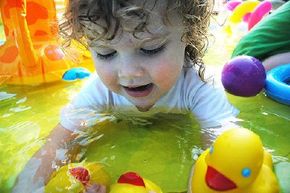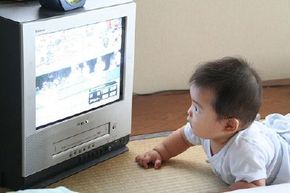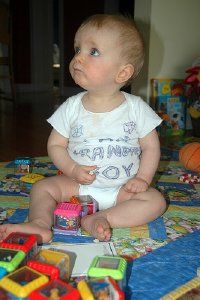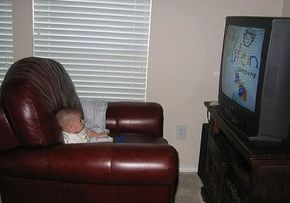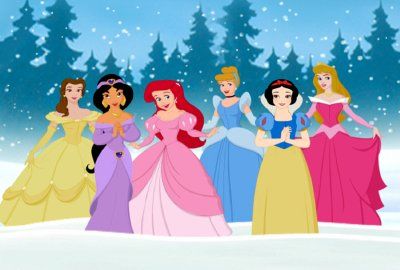With more than 20 videos in the "Baby Einstein" collection, parents can select from a variety of subject matters, as outlined below. Viewing tips are suggested for enhancing the learning experience either during the showing or afterwards. Download video guide here for easy reference.
"Baby Einstein Baby's Favorite Places." Babies 12 months and up are introduced to first words from around town, both spoken and in sign language.
Parent-child viewing tip: Walk or stroll into your own town and explore all the places -- the park, library, school -- seen in the video. Say the word for each place and sign it with your toddler.
"Baby Einstein Meet the Orchestra -- First Instruments." Infants 12 months and up learn about the instruments that make up an orchestra and the different sounds each produces.
Parent-child viewing tip: Create your own orchestra using things around the house. Pot lids become cymbals, a wooden spoon and plastic bowl can be drums, and an empty paper towel tube can be a trumpet.
"Baby Einstein On the Go -- Riding, Sailing and Soaring." Babies 12 months and up are taught about three different modes of transportation: land, water, and air.
Parent-child viewing tip: When you and your child are outside, point at an airplane flying overhead or, as you play at the beach, a saiboat cruising by.
"Baby Wordsworth." Highlights 25 words for common objects found in five places in or around the house: the kitchen, living room, yard, bedroom, and playroom. Children ages nine months and up will be able to understand each word in three ways: written, said aloud, and via sign language.
: Once the video has ended, bring your baby into a room in the home and try identifying an object by signing it and then saying it.
"Baby Monet Discovering the Seasons." A variety of images associated with fall, winter, spring, and summer are presented to viewers four months and up.
Parent-child viewing tip: When watching this video during a particular season, show your baby things outdoors that are related to it -- for instance, a flower during spring or a colored leaf during fall.
"Baby Noah Animal Expedition." Kids 12 months and older will meet more than 20 animals in five different habitats, from all over the world.
Parent-child viewing tip: When each animal is introduced, make a point of saying its name with your child and calling out the sound it makes.
"Baby da Vinci Head to Toe." A cast of animal puppets teach eight different body parts to little ones nine months and up -- all to the tune of "Head, Shoulders, Knees and Toes."
Parent-child viewing tip: Point to each body part and say its name.
"Baby MacDonald A Day On the Farm." Children ages nine months and up will get an inside view of all the activities that take place on a farm, including riding a tractor and celebrating the harvest.
Parent-child viewing tip: Sing "Old MacDonald" with your child and encourage her to name the different sounds each animal makes.
"Baby Bach Musical Adventure." For newborns and older children, this title exposes viewers to a variety of colors and classical music.
Parent-child viewing tip: Show your child a toy or a real version of each instrument as it is being played.
"Baby Beethoven Symphony of Fun." Set to the compositions of Beethoven, newborns and older children are shown a series of different sights and sounds via toys, puppets, and classical music.
Parent-child viewing tip: Make a point of listening to music together with your child during the day, while in the car, or during playtime.
"Baby Galileo Discovering the Sky." Babies ages nine months and up will learn what's overhead as they take a journey to the stars, sky, clouds, and the solar system.
Parent-child viewing tip: Before bedtime, use a telescope or binoculars with older toddlers to help them learn about the wonders of the sky.
"Baby Mozart Music Festival." Newborns and older children can view a variety of different objects, set to the music of Mozart.
Parent-child viewing tip: Encourage your baby to point to objects he or she recognizes on the screen by saying, "Where is the train?" or "Can you show me the blocks?"
"Baby Neptune Discovering Water." Children nine months and up will experience the wonders of water on the beach, in the bath, and in puddles. They'll be able to see water's different purposes: for drinking, cleaning, and playing.
Parent-child viewing tip: Incorporate water into playtime by making water handprints and footprints on paper and then exploring the patterns with your child.
"Baby Newton Discovering Shapes." Sights, motion, and sound set the scene for children ages one and up, as they encounter all kinds of shapes in the world around them. Viewers will learn about circles, ovals, squares, rectangles, and triangles.
Parent-child viewing tip: Go on a scavenger hunt to find similarly shaped objects around the house or in the neighborhood.
"Baby Santa's Music Box." Newborns and older babies can celebrate their first holiday by experiencing festivities and songs of the season from different cultures.
Parent-child viewing tip: Once the DVD is over, extend learning into playtime by playing peek-a-boo with holiday-related objects, such as ornaments or dreidels.
"Baby Shakespeare World of Poetry." Designed to help expand a child's growing vocabulary, toddlers 12 months and up will have their first taste of poetry set to music.
Parent-child viewing tip: Start a conversation with your child about what is happening on the screen. For instance, you can say, "They put the puzzle together. What is it a picture of?" or "Someone is throwing snowballs at the puppet. Who could it be?"
"Baby Van Gogh World of Colors." Children 12 months and up will sample six colors -- red, orange, yellow, green, blue, and purple -- through artwork and music.
Parent-child viewing tip: At 18 months, some children are beginning to sort objects. Help them by counting small groups of similar objects on the screen. For instance, you can say, "There are one, two, three birds. That's three birds total."
"Baby Einstein Language Nursery." Newborns and older can hear their first words in seven different languages: English, Spanish, French, German, Hebrew, Russian, and Japanese.
Parent-child viewing tip: Dance with your child to the music. Encourage her to say and repeat words to you in different languages.
"Baby Einstein Neighborhood Animals." Babies nine months and up will learn about furry friends and other animals that live in and around their homes.
Parent-child viewing tip: As your child begins to understand more words and becomes more verbal, ask her what she is watching: "The dog is eating. What do dogs eat?" or "The cat is looking at the bowl of water. What's swimming in that bowl?"
"Baby Einstein Numbers Nursery." Children 12 months and up can count along, from one to five, with the help of toys and everyday objects, such as apples, hats, and cups.
Parent-child viewing tip: Help your child learn to count as you do laundry. Group shirts, socks, and pants by color and ask your toddler, "How many red shirts are there?" or "How many white socks are in this pile?"
"Baby Einstein World Animals." From the ocean to the jungle, babies nine months and up will be introduced to nine creatures of the wild.
Parent-child viewing tip: Pretend to be different animals. Imitate the sounds that each animal makes and move the way each animal moves.
"Baby's First Move." Little ones ages 6 months and up will be able to move along to the beat, whether it's by clapping, rolling, or dancing.
Parent-child viewing tip: Whatever stage of development your child is in, practice her moves along with her. When she crawls, get down on the floor and join her. If she is sitting and clapping, join in on the fun.
The jury is still out on whether these videos will enhance your child's learning process. If you do choose to watch "Baby Einstein" and other child development videos, be sure to reinforce the learning concepts during one-and-one play.
ABOUT THE AUTHOR:
Pamela Brill, a freelance journalist and mother of a 21/2-year-old, has written parenting articles for Consumers Digest, Fit Pregnancy, and Newsday Parents & Children.


